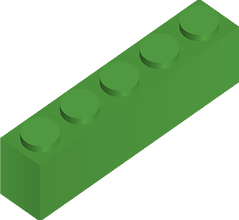

LEGO The World is a supportive application designed for LEGO players to reduce the time spent on preparatory work when they want to build a MOC set, by using the AI sorting technology so that they can quickly get into the building process which the most enjoyable part.




LEGO
THE WORLD




Client
Thesis Project
Committee Members
Mike Strobert
Project Brief
A supportive application designed for LEGO players to reduce the time spent on preparatory work when they want to build a MOC set, by using the AI sorting technology.
Role
Research, UI/UX design, Motion
Joyce Hertzson
When
Spring 2020
Tools




“I personally think that Lego, building in accordance with the instructions in the first basic gameplay, and ultimately it is necessary to reconstruct and design your own model with these basic parts. This is the ultimate charm of Lego toys.”
A fan of LEGO, MOC player
MOC stands for LEGO My Own Creation or My Own Creation. LEGO MOCs are not official LEGO sets. But designed and built by LEGO fans.
PROMPT
Improving LEGO players' playing experience when they want to build a MOC set, by helping them quickly get into the building process which is the most enjoyable part.

PROBLEM
Players spend too much time on preparatory work which is painful but necessary.

What is Preparatory Work?

Parts Check
Always check the parts they have before build.
Normally, a set at least has hundreds or more than thousands of parts.

Find Missing Parts
Shop the parts online or in stores separately costs time.
Especially, some parts are so rare that cost a lot of time to find.

Classification
Not like the LEGO official set, the parts well classified.
Most players have no clue because they do not know how to do it is better.
SOLUTION
I’m building an app that can reduce the time spent on preparatory work by
-
Create a Digital Library
-
Alternative Parts
-
Flexible Classification

RESEARCH
Questionnaire
To general understand users' situation.
The ten participators were between 15 and 32 years old.
According to the result, parts check is the most important process that players cannot make mistakes because if either one of those stages had a problem, it would affect the building process.
About the parts check, most players think they are even more focused than they are in the building process. Under this situation, they may make mistakes because of nervousness and spend more time on It to prevent mistakes happen. Occasionally, some missing parts are hard to buy because they were produced decades ago.
About the parts classification, all players have a certain kind of confusion about it.
Senior players have some experience to handle it. But for beginners, do not know what to do.


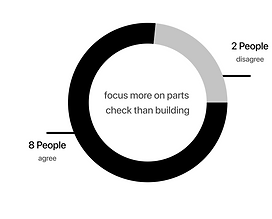


Journey Map
To understand how users go through in order to accomplish a goal.

Preparatory Work
Conclusion
Apparently, compared with the building process stage, users are frustrated and spend too much time at the preparatory work stage.
Building Process
Pain Points
-
Parts check
-
Find the missing parts
-
Parts Classification
Talk to interviewee

Zack Zhou
Age: 20 years old
Gender: male
Occupation: student
Play LEGO: 2 years
“This MOC set does not need much time to build, but it still took me a few days to finish it. I spent 2 days searching for rare parts online or in stores."
Pain Point
The rare parts are really hard to find anywhere.
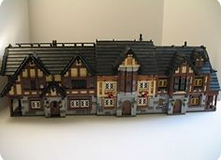
Ana Liu
Age: 27 years old
Gender: female
Occupation: clerk
Play LEGO: 7 years
“There have thousands of parts that waited for me to check with the inventory of building instruction. I really hope to get this work done as quick as possible”
Pain Point
Parts check is necessary and time-consuming work.

Mike Han
Age: 29 years old
Gender: male
Occupation: clerk
Play LEGO: 4 months
“I am not quite familiar with parts classification because I usually play the LEGO official set. I do not any idea about how to classify parts is good for me. I guess I have to try it out. ”
Pain Point
Classification confused players. They do not know how to do.
Persona
Who the people are? What do the people need?

Find the Cause of Part Check Problem
LEGO Bricks
Six 2×4 LEGO bricks can be combined in more than 915 million ways. And there are 6800 different kinds of brick right now. The estimated number of LEGO pieces for every human on earth is 82 pieces. 1,300 LEGO pieces are made per second, 78,000 per minute, and 4,680,000 per hour.
Reference: https://mamainthenow.com/fun-lego-facts/
The Habit of MOC Players
MOC players would like to stack a large number of bricks and regularly buy in more new bricks because they want to make sure they are ready to build when they want to.
As the right pictures show, holding a large number of parts inevitably causes MOC players are hard to keep track of how many bricks they have because they are so many and different from each other. It is almost impossible to count them in the mind or even in handwriting. That is why the parts check costs time so much.
Image Reference:
https://www.pingwest.com/a/199965


Conclusion
To change this situation, they need a tool or an app that can record all bricks in a digital version, like a digital library. First, a digital library is clearer on visuals than a wall or boxes of bricks. Second, a digital library could be interactive with other digital information or data.
Find the Solution to Part Check Problem
AI Sorting Technology
An effective and possible way to digitalize bricks
Australian software engineer Daniel West wants to design a Lego sorter with the help of computer vision algorithms, any Lego parts can be sorted out.
Step 1: Put in the bricks
Pour a lot of Lego bricks into the chute on the top of the machine, then place the bricks on the vibrating belt. After shaking, the bricks are scattered into individual bricks.
Step 2: Take photos and make classification
The Raspberry Pi computer contains a camera. When the building blocks pass by, it will take a series of photos, and then send these photos to the CNN model ResNet-50 for classification.
Step 3: Sorting into the box
After the classification results are fed back to the equipment, different small gates on the conveyor belt will guide the blocks to their respective boxes.
AI Sorting: https://www.youtube.com/watch?v=-UGl0ZOCgwQ

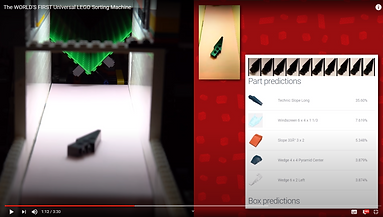

Conclusion
AI sorting technology has been already practiced on the computer and worked well.
In my view, it is possible to transplant the technology from a computer to a mobile device, such as an iPhone. With the help of AI sorting technology, we could create a digital library on the iPhone. We require players to take photos of bricks by phone camera and import photos into the app for analysis, based on programmed algorithms. "With machine learning, the algorithms would look for patterns in data and make better decisions in the future based on the examples that we provided."
Reference:
“What is Machine Learning? A Definition” expert.ai. Originally published March 2017, updated May 2020. https://www.expert.ai/blog/machine-learning-definition/
Find the Cause of
Some Missing Parts are Hard to Find Problem
Development of LEGO
Up to now, the Lego company has been producing plastic bricks for over a half-century.
In 1949, the forerunner of the Lego bricks we know today is launched under the “Automatic Binding Bricks” That is the first time Lego start to produce ABS plastic bricks. When the time comes in 1958, the Lego bricks is patented with a new coupling principle, the one we know today, opening up to endless building possibility.
Owning to the LEGO system of play, all modern Lego bricks we know today by introducing tubes on the underside which made the bricks more stable and allowed for more combination. From that time, Lego followed the stander and coupling principle to design new bricks and produce tons of bricks every year.

Lego First Plastic Bricks, 1949

Lego System of Play, 1958
Conclusion
Based on the information I gathered, most of the missing parts are easy to buy, but some particular parts are hard to find mostly due to the year of production. After all, the Lego company produces tons of bricks every year, including new designs. It is a common phenomenon that a small proportion of bricks gradually are hard to find as time goes. We could find the replacement.
Find the Solution of
Some Missing Parts are Hard to Find Problem
Alternative parts
Since 1958, Lego started to produce modern brick we know today in a split of those bricks have different color, size, textures, or paint stuck on the surface. But those bricks are followed the coupling principle. And they use the same structure with studs, tubes, and bars. This means that if players were looking for rare parts, the app could provide some parts that have the same structure and size to replace the rare one as an alternative option. In this way, players save lots of time to search for the parts.

Examples of Alternative Part
Find the Solution of Parts Classification
The situation of MOC
The Lego official sets are designed and packed well to sell by Lego.
However, MOC is designed by Lego players, and build with Lego bricks. Normally, players would display their MOC online with pictures, if viewers were interested, they would pay for instruction. And they need to do the rest on their own.
Parts Classification of the Lego Offical Sets
Speak about parts classification of the Lego official set, players mostly like it. Lego official sets use goal-setting theory to motivate players to achieve the final outcomes.
Firstly, the official sets classify the whole parts into several bags, just like separate goals to the final goal. The average number of parts is from a hundred to three hundred. When players build, they just need to finish the work of each bag by numbers on instruction. Finally, players would get the whole picture. In this process, each bag is an achievable goal and gives a rewarding feeling to players after they finished.
Conclusion
According to the study on parts classification of the Lego official sets, I have the solution about the parts classification of MOC. The app would let players set their goals. The app would give basic information, such as the estimated time to build and how many parts in total number. Considering the information provided by the app, players make decisions about how many parts in one group. After all, players have a different experience of playing Lego. For senior players, they could set the number higher for challenging. For beginners, they could set a comfortable number.
INTRODUCING
LEGO The World
For LEGO players to have a better playing experience to build MOC. It is a mobile platform to share and discover ideas about how a thing in this world can be built in LEGO. Also, it provides supports which reduces time spent on preparatory work
With the supports, players quickly get into the building process which they enjoy.

Homepage
OBJECTIVES

Digital Library
Once the AI sorting recorded all brick in digital and created a digital library in the app, the app would automatically compare the parts listed on instruction with the digital library. The app could immediately show the MOC in two categories, the one is that players can build right now, the other one is that players miss some parts. If players shorted some parts on a set picked, the app would directly show which parts they need to buy. Digital library almost cuts the time spent on the parts check process and helps players to quickly get into the building process.

Alternative Parts
The app detected the missing parts are produced decades ago, it would recommend the player to pick alternative parts that have the same structure and size to replace the original one listed on the instruction. In this way, players save time to search for the parts.
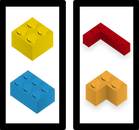
Flexible Classification
The app would let players set their goals. The app would give basic information, such as the estimated time to build and how many parts in total number. Considering the information provided by the app, players make decisions about how many parts in one group. After all, players have a different experience of playing Lego.
APPLIED SOLUTION
How LEGO The World Work?

Create
A Digital Library
Cut the time spent on the parts check and lead the user easily to the next stage.
Once the user has a digital library, the app would show the set that the user can build right now or the match rate of the set needs compared with the digital library. Also, the user can update the library on the digital library page.


Pick a Set and
Shop Missing Parts
When players need to buy rare parts, the app provides alternative parts that can solve the problem quickly.
Directly show the user what parts were missing if they pick a set in the build later category. The app provides alternative parts to replace rare parts for saving time to search for rare parts.


Make a
Parts Classification
The better way to classify the parts is to let players set their goals.
The app would give basic information, such as the estimated time to build and how many parts in total number. Considering the information provided by the app, players make decisions about how many parts in one group. After all, players have a different experience of playing Lego.



Create a digital library

Pick a set and shop the missing parts

Make a parts classification

Create a digital library
How could we create an engaging experience
Homepage - overview

1. Mega Menu
Big, two- dimensional panels divided into groups of navigation options.
2. Search Button
The user can search a certain kind of set by key wards, theme, or parts number.
3. Filter Button
The user gets more precise information.
4. Gallery
HD images attract the user's focus.
5. Liked Button
The user can quickly collect a set for later further exploring
6. Navigation Bar
Help the user quickly go to the category they are interested in.
(Homepage, Build, Digital Library, Account)
The set page - overview

1. Ese Button
The user can close this window and get back to the homepage.
2. Set Graphic
HD images give the user a detailed look from different angles.
3. Set Content
Show the name, category, number of parts, designer, match rate, and the missing parts which compared the set with digital library.
4. Instruction
Buy and download the instruction
5. Buy Parts
Make a shopping list of the missing parts and guide the user to shop them online.
Build page - overview

1. Mega Menu
Big, two- dimensional panels divided into groups of navigation options.
2. Search and Filter Button
The user can search for a certain kind of set or gets more precise information.
3. Set Instruction Content
Show the set information and lead the user to the parts classification stage.
Set instruction and classification - overview

1. Set Graphic
HD images give the user a detailed look from different angles.


4. Parts Classification
Help the user to classify the parts.
7. Parts Chart
The user can slide the bar in the chart to decide how many parts in every group.
2. Ese Button
The user can get back to the build page and view the set instruction list.
5. Scroll down
If the user scrolled down the page, the interface would change for showing the information in a better view.
8. Groups Content
The user classifies the parts as the group shows. Click in to get more information.
3. Set Content
Show the set information and the inventory of parts needed.
6. Parts and Time Cost
Give a better understanding to the user before they do parts classification work.
9. Start Build Button
When the user gets all groups ready, they can get into the building process.
Digital library page - overview

1. View the Library
Get detailed information about the current digital library.
2. Update by Taking Photos
Take photos of the new parts for updating the digital library.
3. Update by Importing Photos
Select the photos of the new parts in the album and import them for library updates.
WIREFRAMES DESIGN
UI Patterns
When users choose their favorite sets, the most important factor is whether the appearance of the product can motivate them to play. So my interface design is based on a gallery pattern, with pictures as the visual center. In this way, you can grab the user's attention for the first time and save them time to filter information.

sketches

sketches

sketches

sketches
Wireframe of Create a Digital Library

Wireframe of Shop Missing parts

Wireframe of Parts Classification

GRAPHICS DESIGN
Moodboard
This is designed for LEGO players. They like geometric edges, creative shapes, or attractive colors.
Keywords: geometric, creative, attractive

Reference
https://www.pinterest.com/pin/857583954033134286/?nic_v2=1a7iFsfVV
https://www.pinterest.com/pin/229754018459893560/?nic_v2=1a7iFsfVV
https://www.pinterest.com/pin/354799276901773824/?nic_v2=1a7iFsfVV
Styleboard
The visual solution is based on gallery patterns.
Attract users' attention with HD images.
Keywords: gallery, images

Reference
https://www.uplabs.com/posts/unsplash-app
https://www.pinterest.com/pin/349451252333314783/?nic_v2=1a7iFsfVV
Color Palette

Typography

Icon
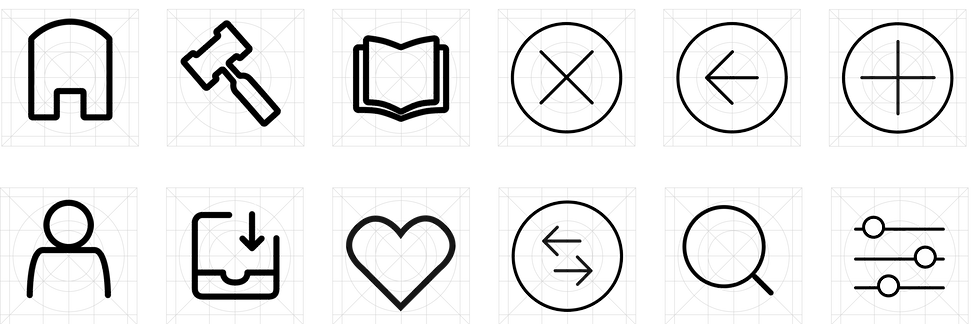
Grid System

4 Columns, Gutter 16px, Width 72px
5 Columns, Gutter 8px, Width 8px
5 Columns, Gutter 8px, Width 8px
5 Columns, Gutter 8px, Width 8px
375px * 812px
REVIEWS & EVALUATION
6 volunteers whose ages are between 21- 27 years old participated in the usability testing of this application. The wireframe of the application was printed out for them to finish the testing, After introducing the application, volunteers were required to finish some tasks and answer several questions.
All volunteers had fully understood the workflow of the application from picking a set at the beginning to start building at the end. All volunteers like the AI sorting technology used in the app because it solved their major problem.
Speak about the future development of the app, volunteers hope there is a kind of physic machine that could help them to manage or sort out the parts they want by connecting with their smartphones. Obviously, AI makes less mistake than human.
CONCLUSION
I successfully solved the problem that LEGO players spend too much time on preparatory work when they want to build a MOC. The overall design of the app is succeeded, it could effectively help players to the building process which they enjoy the most.
Especially the solution of the parts check problem, by using AI sorting technology through the camera on the mobile device, it helps players to create a digital library which transfers the players' bricks into the data. And it could be interactive with other digital information. Also, the digital library is clearer on visuals than a wall or boxes of bricks. Plus, it can be updated by taking or importing new photos of brick. The digital library almost cuts the time spent on the parts check process and helps players to quickly get into the building process. Players also not feel frustrated at preparatory work. With the help of the digital library, players have the motivation to build more in the future.
What's more, players have a platform to share and discover ideas about how a thing in this world can be built in LEGO which is interesting to view this world or things around them. With a creative mind, players will have more fun and happiness when they playing LEGO.
